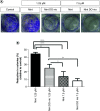Cationically modified inhalable nintedanib niosomes: enhancing therapeutic activity against non-small-cell lung cancer
- PMID: 36004583
- PMCID: PMC9583758
- DOI: 10.2217/nnm-2022-0045
Cationically modified inhalable nintedanib niosomes: enhancing therapeutic activity against non-small-cell lung cancer
Abstract
Aim: This study was designed to develop and test nintedanib-loaded niosomes as inhalable carriers for enhancing its therapeutic efficacy via localized drug accumulation and addressing issues such as low bioavailability and severe toxicity. Methods: Niosomes were prepared by thin-film hydration method and were evaluated for in vitro therapeutic effectiveness in lung cancer cells. Results: The optimized niosomal formulation displayed optimized vesicle size, controlled and extended release of drug, and efficient aerodynamic properties indicating its suitability as an aerosolized formulation. In vitro studies revealed significantly superior cytotoxicity of nintedanib-loaded niosomes which was further validated by 3D spheroids. Conclusion: These findings establish the effectiveness of niosomes as inhalable delivery carriers which could serve as a promising strategy for delivery of nintedanib to treat several lung cancers.
Keywords: aerosol; cationically modified vesicles; inhalable delivery carrier; nintedanib; niosomes; non-small-cell lung cancer; tyrosine kinase.
Figures








Similar articles
-
Sorafenib Loaded Inhalable Polymeric Nanocarriers against Non-Small Cell Lung Cancer.Pharm Res. 2020 Mar 12;37(3):67. doi: 10.1007/s11095-020-02790-3. Pharm Res. 2020. PMID: 32166411
-
Highly in vitro anti-cancer activity of melittin-loaded niosomes on non-small cell lung cancer cells.Toxicon. 2024 Apr;241:107673. doi: 10.1016/j.toxicon.2024.107673. Epub 2024 Mar 1. Toxicon. 2024. PMID: 38432612
-
Development of Niosomal Vesicles Loaded Mometasone Furoate Gel for Transdermal Delivery and its Evaluation.Recent Adv Drug Deliv Formul. 2023;17(4):300-313. doi: 10.2174/0126673878259437231031114907. Recent Adv Drug Deliv Formul. 2023. PMID: 37974444
-
Delivery of vinblastine-containing niosomes results in potent in vitro/in vivo cytotoxicity on tumor cells.Drug Dev Ind Pharm. 2018 Aug;44(8):1371-1376. doi: 10.1080/03639045.2018.1451880. Epub 2018 Apr 11. Drug Dev Ind Pharm. 2018. PMID: 29532687
-
Bioavailability enhancement of vitamin E TPGS liposomes of nintedanib esylate: formulation optimization, cytotoxicity and pharmacokinetic studies.Drug Deliv Transl Res. 2022 Nov;12(11):2856-2864. doi: 10.1007/s13346-022-01148-z. Epub 2022 Mar 23. Drug Deliv Transl Res. 2022. PMID: 35322372
Cited by
-
Niosomes: Composition, Formulation Techniques, and Recent Progress as Delivery Systems in Cancer Therapy.Pharmaceutics. 2024 Feb 4;16(2):223. doi: 10.3390/pharmaceutics16020223. Pharmaceutics. 2024. PMID: 38399277 Free PMC article. Review.
-
Investigating the Potential of Ufasomes Laden with Nintedanib as an Optimized Targeted Lung Nanoparadigm for Accentuated Tackling of Idiopathic Pulmonary Fibrosis.Pharmaceuticals (Basel). 2024 Nov 28;17(12):1605. doi: 10.3390/ph17121605. Pharmaceuticals (Basel). 2024. PMID: 39770447 Free PMC article.
-
Functional Evaluation of Niosomes Utilizing Surfactants in Nanomedicine Applications.Int J Nanomedicine. 2024 Oct 10;19:10283-10305. doi: 10.2147/IJN.S480639. eCollection 2024. Int J Nanomedicine. 2024. PMID: 39403709 Free PMC article. Review.
-
Development and Characterization of Novel Combinations and Compositions of Nanostructured Lipid Carrier Formulations Loaded with Trans-Resveratrol for Pulmonary Drug Delivery.Pharmaceutics. 2024 Dec 12;16(12):1589. doi: 10.3390/pharmaceutics16121589. Pharmaceutics. 2024. PMID: 39771567 Free PMC article.
-
The Impact of Hyaluronic Acid Coating on the Cationic Niosomal Surface for Doxorubicin Delivery.Molecules. 2025 Mar 3;30(5):1148. doi: 10.3390/molecules30051148. Molecules. 2025. PMID: 40076371 Free PMC article.
References
-
- American Cancer Society (2022). Lung cancer statistics: how common is lung cancer. www.cancer.org/cancer/lung-cancer/about/key-statistics.html
-
- WHO (2022). Cancer. www.who.int/news-room/fact-sheets/detail/cancer
-
- National Cancer Institute. Browse the SEER cancer statistics review 1975–2017 (2020). https://seer.cancer.gov/csr/1975_2017/browse_csr.php?sectionSEL=15&pageS...
Publication types
MeSH terms
Substances
Grants and funding
LinkOut - more resources
Full Text Sources
Medical
